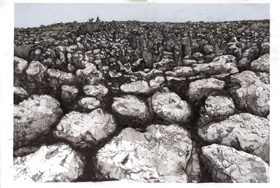MArch (Prof) Thesis Supervisor: Daniel K. Brown
School of Architecture, Victoria University of Wellington
Katsougiannis, Mihali. OVER YOUR CITIES GRASS WILL GROW: Master of Landscape Architecture 2016.
Over Your Cities Grass Will Grow is the title of a documentary film about German artist Anselm Kiefer and the land art that he created in Barjac, France to symbolise the devastating cultural deformations resulting from World War II. At the end of the film, Kiefer says “Over your cities grass will grow.” He is paraphrasing line 34:13 from the Book of Isaiah: “Thistles will take over, covering the castles, / fortresses conquered by weeds and thornbushes”. Chapter 34 of the Book of Isaiah is about God’s anger at mankind’s “arms and armies” – “generation after generation, the same old thing”. The thesis investigation is sited in the abandoned Greek town of Levissi, Turkey. Deserted and left to ruin by a devastating war, thistles have taken over the city, the houses conquered by weeds and thorn bushes. This thesis explores how landscape architecture can help prevent the ultimate disappearance of abandoned villages like Levissi — preserving them for future generations, to help them remember these tragic events, so that they may never happen again.
Abstract: Around the world lie dormant landscapes, altered by mankind and subsequently abandoned. Often these sites contain cultural significance that UNESCO works endlessly to protect, conserve and manage; but what of the sites they cannot, as for example ruins from our own time that have not yet gained the official moniker ‘heritage site’? What is to become of them? Will they become lost to time, or can Landscape Architecture provide the necessary incision to ensure their survival? In the abandoned Greek town of Levissi, Turkey – deserted and displaced by a devastating war – thistles have taken over the city, the houses conquered by weeds and thorn bushes. Without a viable plan to preserve the site, the town has been left to slowly decay; this thesis explores how landscape architecture can help prevent the further destruction of Levissi, preserving both the landscape and its story – by integrating resilience with narrative design – for future generations to help them remember this event so that it may never happen again.
This thesis investigates how Landscape Architecture can help to mitigate the environmental weathering of culturally significant ruins and help to prolong their life with the use of contemporary interventions that can serve as the catalyst for further revitalization of these abandoned sites. The thesis proposes that through contemporary design we can create a humble palimpsest born out of admiration for a site – not from the simple goal to preserve, but to also understand the place – which in turn can enable a culturally significant contemporary landscape to survive and provide the foundation for it to become a protected World Heritage Site in the future.



































































